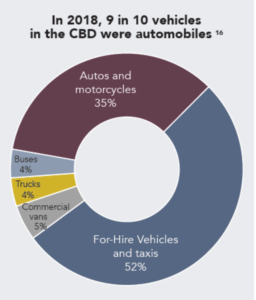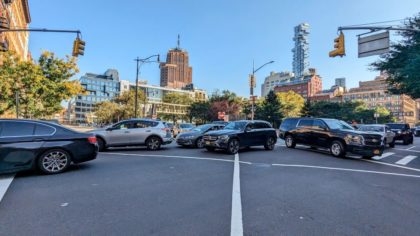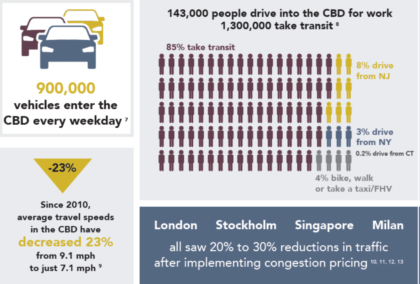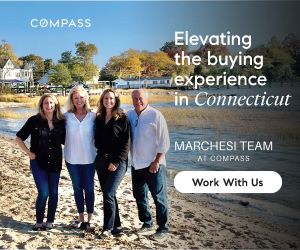Congestion pricing plan will charge $15 to drive Downtown
The recommendations issued yesterday by the Traffic Mobility Review Board — the group of five experts tasked with hashing this whole congestion pricing thing out — adds a lot of clarity (finally) for Downtowners. The short answer: cars will be tolled $15 a day, no more than once a day, between 5a and 9p on weekdays, and between 9a and 9p on weekends. Toll rates should be 75 percent lower in the off-hours.
But wait, there’s more! Cars will only be tolled for ENTERING the Central Business District, which is south of 60th Street. (For answers to other scenarios, see this post and this post.)
This is very different than what the MTA originally discussed, when it ran through several scenarios with me both on the phone and in their massive reports and many hearings. Previously the plan was to toll drivers entering AND exiting the CBD, so, for example, a weekend trip would require two tolls. Now the only toll will be to enter.
The Review Board threw Downtown a bone here, and made the plan a lot simpler. And before you bring up London, the report authors have an explanation for that too: “Some commenters have suggested that New York should follow London’s model in offering a 90% discount for residents of the zone. However, London’s program charges a toll on all trips within the zone, while under the recommended Program, trips made entirely within the Manhattan CBD generally would not be subject to a toll.”
There is a caveat there however when it comes to taxis — their proposal adds that while taxis coming into the CBD will be exempt, there should be a per-ride fare for rides made to, from or within the CBD of $1.25 per-ride for taxis and $2.50 per-ride for app-based for-hire-vehicles.
And here’s the long answer, distilled from the report:
• Trucks should be charged a $24 or $36 depend on their size.
• Buses providing commuter services should be exempted from the toll.
• Motorcycles should be charged half the passenger vehicle toll.
• Tolls should be charged to vehicles only as they enter the CBD – not if they remain in or leave the zone.
• Vehicles entering the CBD during the congestion hours above and through the Queens-Midtown, Hugh L. Carey, Holland and Lincoln Tunnels should get a credit against the daytime toll rate of $5 for passenger vehicles.
• NYC Taxi and Limousine Commission (TLC)-licensed taxis and For-Hire Vehicles (FHVs) should be exempted from the daily system toll on vehicles. Instead, a per-ride CBD toll should be added to each paid passenger trip fare for rides made to, from, or within the CBD at the toll rate of $1.25 per-ride for taxis and $2.50 per-ride for app-based FHVs.
• Specialized government vehicles should be exempted.
• Low-income vehicle owners who qualify and register with TBTA should receive a 50 percent discount on the daytime auto toll after the first 10 trips made by that vehicle in a calendar month.
From here, their recommendations go to the Triborough Bridge and Tunnel Authority board, which will begin a public review process, including a 60-day public comment period and public hearings to be held in February 2024, before a final vote of the MTA board. Tolling could be in place by May.
The report does do a very smart job of being both granular (down to the rationale for not exempting electric vehicles) and big picture.
“Traffic in New York’s central business district is choking the region – with the worst congestion in the nation. Traffic is bad for public health – increasing air and noise pollution and increasing emergency vehicle response times. It is bad for the economy – costing businesses, commuters, and residents a staggering $20 billion a year. And it’s bad for the quality of life in New York…Congestion Pricing should contribute to – not undermine – the region’s economy. Our recommended toll structure prioritizes keeping the toll rates low, in part by limiting the number of credits, discounts and exemptions. It is designed to consider the interests of the many over the few.”
A few more details:
WEEKENDS
Some folks have argued that weekends should be exempt, but the report notes that on weekends, traffic patterns are surprisingly comparable, unlike many other urban areas in the US. But traffic speeds slow down later in the morning on weekends than on weekdays, hence the 9a start.
ELECTRIC VEHICLES
There was talk about exempting EVs, but the obvious answer here: they still contribute to congestion, if not pollution.
MEDICAL APPOINTMENTS
The report did not recommend an exemption for people using cars to get to medical appointments because several programs exist today that already offer free or discounted transportation to medical appointments: Medicaid and Medicare Advantage enrollees, which cover low-income people and people with developmental disabilities, as well as veterans and some people aged 60 and older. Access-A-Ride (AAR) Paratransit Service provides public transportation for eligible customers with disabilities or health conditions that prevent them from using the public transit. And transportation costs to medical appointments are eligible for reimbursement with Flexible Spending Accounts, Health Savings Accounts, and Health Reimbursement Arrangements.
THE DEFINITION OF THE CBD
Manhattan south of and inclusive of 60th Street, but excluding the FDR Drive, the West Side Highway, and any surface roadway portion of the Hugh L. Carey Tunnel connecting to West Street.
I will note that I really trust and admire the work of Carl Weisbrod, who has had a role in nearly every city planning issue of the past four decades and who knows Downtown: he was the founding president of the Downtown Alliance and president of real estate for Trinity Church. But also the report is pretty easy to digest. In fact, of all the documents that have come out of this process, this is the first that did not make my head spin. If you are someone who likes to go to the source, find it here, under Project Update.
















Finally. This is a well balanced plan. Looking forward to reduced traffic, particularly on Canal.
I agree with K. I also think that we should expand the CBD to 96th Street, Roosevelt Island, downtown Brooklyn and parts of Queens. Why should government officials who voted for the CBD in our area not be affected too? There is a lot of congestion between 60th street and 96th street. We should also reduce the number of Ubers by half. It’s easy if you only set rules like allowing their cars on the street 4 days a week, based on their license plate numbers. End with an even number, drive on even number days, etc.
While I don’t have a problem with this idea here are my issues:
1. My understanding is this fee is being handled by the MTA- they also handle public transportation into nyc. So why are they not being told to lower fares into the city since now they have more money . Two who will stop them from continuing to raise bus,subway fares in the future when they see this doesn’t raise enough money? 3. What is this money being used for? How about reduce other transportation fees since you are forcing people to use mass transit. 4. The reason I drive is for safety and subways and crime is worse in the city now, please explain how this idea will not get me robbed or killed. 5. Will NYC be adding more buses and trains to handle more people ?
This whole scheme is to MAKE money for the MTA for improvements, not to break even. In fact, it is obliged by state law to generate at least $1 billion in extra revenue for the MTA.
It’s about time.
Private auto use in an urban area as dense and transit-rich as Manhattan should be disincentivized by all means available.
Would be great to see meaningful additional investment in pedestrian safety infrastructure, express bus lanes and improved subway frequency (and cleanliness/safety) as congestion pricing rolls out. Perhaps Mayor Erdogan can finally earn his keep.
CP is supposed to be for MTA subway capital projects – nothing else.
BTW CP won’t help bus riders at all.
The MTA has been reducing bus routes, bus frequency and bus stops for years.
Not what I wrote.
To restate: it would have been, and still is, a good idea for our city leaders to roll out those other improvements I’ve listed concurrent w congestion pricing, so that NYC-area residents can begin to see meaningful improvements in transit, cleanliness and safety as costs on car ownership increase.
This is a statement of wish, not reality (at least not under Mayor Erdogan).
Can’t wait until this does absolutely nothing to alleviate traffic congestion or improve the subway.
Also, not sure why everyone thinks people who owns a car in NYC just use it to commute all over the city and use it to avoid the subway. Maybe some uber wealthy do, but I own one here in lower Manhattan because for work I have to commute to Rockland, North Jersey, and Staten Island frequently. Whenever I commute anywhere in the city though I take the subway because driving and parking is a nightmare to be avoided at all costs.
My gripe is that I already pay tolls to come into the city and pay exorbitant fees for the privilege to own a car and park it here. I also pay for a subway card.
I’d maybe get on board with this if the MTA first started cracking down on people who jump the turnstiles who cost the system millions in lost revenue every year instead of turning their rage on drivers to instead subsidize a system they don’t even use because it may not even be a practical choice for them.
Something tells me though that people will still be jumping the turnstiles after this is done.
Freakonomics just updated their podcast on transit and actually in most cities fare collection only accounts for ~10% of revenues for a transit org. Most funding comes from state and federal funding. I don’t know figures for NYC but fare evasion is not what is going to help the MTA.
In NYC, it’s different: The MTA gets about 23% of its operating budget from fares. Total operating budget is about $19 billion. $6.8 billion comes from fares. Estimates for losses via fare evasion: $700 million in 2022; close to $1 billion in 2023. So that’s a 14% loss. These sound low. I don’t know how they calculate those losses. However, I suspect the loss is even hire, since other estimates of recent evasion rates are much higher than 14%. So the losses are probably a much higher percent than that.
Sources: https://new.mta.info/budget/MTA-operating-budget-basics
2022 rates:
“In Q4 2022, subway evasion was 13.5 percent, which means about 400,000 riders did not pay on an average weekday. That’s enough to fill Yankee Stadium eight times. On buses, the rate was a staggering 37 percent in Q4 2022, which means an average weekday saw 700,000 bus riders not pay their fares. This would fill Citi Field, where the New York Mets play, 16 times.”
Source: https://www.masstransitmag.com/technology/fare-collection/article/53060940/mta-loses-an-estimated-690-million-due-to-fare-and-toll-evasion
Rates are even higher in 2023: 40% on buses; not sure about subway.
“The first quarter of 2023 (January–March) saw an increase [in evasion] of 11.1% (± 0.9%) for subways and an estimated increase of 37.6% for buses. .”
https://www.osc.ny.gov/state-agencies/audits/2023/06/22/fare-evasion-follow
Beyond money, there’s the social cost of free-riders.
“It tears at the social contract that supports mass transit in New York City. New Yorkers are sick of feeling like suckers seeing their neighbors beat the fare or cheat the toll while they pony up their fair share.” said MTA Chair and CEO Janno Lieber.
https://www.masstransitmag.com/technology/fare-collection/article/53060940/mta-loses-an-estimated-690-million-due-to-fare-and-toll-evasion
I’m all for this. I assume they will charge based on license plate.
Sadly, I keep seeing more and more cars that purposely damage their license plates so that scanners can not read them. Hopefully there is a crackdown on this as it’s a problem that is getting worse.
There is no exemption for city employees working downtown, correct? What about police cars, will they pay? I’m tempted to organize some kind of “concerned citizens for placard abuse in congestion pricing” so that we don’t wind up with an exacerbation of the existing parking placard issues in the neighborhood..
(I see the “specialized government vehicle” exemption but I’m hoping that’s, like, firetrucks and collections busses, not “random normal cars owned by DOB clerks or police sergeants”)
Specialized government vehicles are things like garbage trucks, salt spreaders, and street sweepers. They specifically exclude even publicly-owned passenger vehicles from that exemption (privately-owned vehicles are, of course, excluded from the exemption).
Totally agreed. So many of the parked cars in the neighborhood have placards for working at city agencies. In my experience, most of the drivers do not actually work at any city agency and get the placards from friends and relatives.
In my opinion, these were also the people that were fighting the hardest to not have congestion pricing and I assume they will fight tooth and nail to not have to pay anything.
Emergency vehicles (firetrucks, police cruisers, ambulances, etc.) are exempt by law, but the TMRB recommended that associated personal vehicles (i.e. a police officer or firefighter’s personal vehicle) not be exempt.
The report is very thorough and only ~10 pages — https://new.mta.info/document/127761 — give it a look.
One question: Supposing I live in Tribeca on Reade Street, if leave my house and get onto the West Side Highway at Chambers and start heading North and then exit at Clarkson and return home. Will I be charged?
It doesn’t seem like you would under this scheme. Only if you went north of 60th street and came back.
I hope so. But if the WSH and FDR are exempt, but you then enter the zone below 60th St, you should be charged, assuming you entered above 60th or from BBT or the East river crossings.
In theory no, since the highways are exempt and driving WITHIN the CBD is not tolled. But I see the issue, since you will go through a detection point when you cross back at Clarkson. So I think this is a wait and see…
I thought that was covered in this post:
https://tribecacitizen.com/2023/08/14/clarity-finally-on-one-angle-of-congestion-pricing-for-downtown-residents/
Which said that trips that entered and departed the WSH from within the CBD wouldn’t be charged?
Do we have any more of a definitive answer to this question?
I am pretty confident that in this scenario you will NOT be tolled.
Lyft & Uber cause 43% of the congestion on midtown streets; as well as taking ridership from the MTA. Residents with cars use their vehicles to leave Manhattan not to drive around midtown as these app for hire vehicles do. What are these companies paying to the city for the hundreds of vehicles from their fleets clogging our streets?
Very good point. And don’t forget all the food delivery apps that cause chaos on the streets and sometimes on the sidewalks with e-bikes and mopeds, I have witnessed a pack of delivery riders of mopeds( motorcycles?) racing down the street.
all this is part of the Covid reset phenomenon.
Spot on, K.
Agree and if you look at chart above largest % is for hire cars. I see there are additional fees which get passed into riders but Uber and Lyft should definitely have to pay more overall as well and either they take on the $15 enter /exit fees per drivers or drivers do as a cost of doing business. I suspect we would see a large reduction in Ubers and Lyfts and hopefully more taxis back if that was the case (which are better regulated)
A wrinkle on the trade/Clarkson question: I live downtown and park at Pier 40. I pay to enter zone when I return to city to my apartment, drop off stuff and then go park on the pier. Am I charged a second time when I retrieve my car, go to house to pick up stuff and then exit city?
While you will be detected, I am pretty certain you will NOT be tolled when you go from with the CBD onto the highway and to Pier 40, which is still within the CBD since all that travel is not tolled. You *will* be tolled when you return home the first time.
I remember when I was assured that Bloomberg’s smoking ban in bars and restaurants would destroy the city.
New York, we will survive this. London, Stockholm and Singapore did. Many Italian cities have very restricted areas you can drive in. You don’t have to pay charge, if you drive there you pay a fine. It is coming and we may have to adjust to it but in a few months it will be like we always had it.
Thanks for all of the info. How will this impact residents of Battery Park City who park in BPC? For example, if I leave my apt in my car from BPC and cross the West Side Highway and travel into Union Square and then later travel back and return to my apartment and garage into BPC – would I be tolled at all?
Similarly, would taxis be charged for picking me up at my apt in BPC and taking me to Union Square? Thanks!
The first part, no. The second part, see the post about how taxis will deliver fees for trips within the CBD.
What about coming in the CBD zone, where I live, from Staten Island/Brooklyn over the Brooklyn Bridge and also the Williamsburg Bridge?
You will get tolled when you enter the street grid.
If you like more empty storefronts in Tribeca, then embrace Congestion Pricing. Most businesses in Tribeca cannot be sustained by local residents alone. This is particularly true for restaurants, who rely on a steady and reliable stream of guests from the Tri-State area and beyond. Congestion pricing is a money grab tax on drivers for the MTA, whose record of managing money is abysmal. Congestion pricing is just another barrier to potential diners and retail shoppers to do business here. They will make their purchases elsewhere. It will also be detrimental to Broadway and the Theater District. If you truly want to improve traffic flow below 60th street and elsewhere throughout NYC, stop narrowing the roads, and create jobs for new Traffic Agents, and dispatch them to key intersections throughout the city,
Sorry no room for common sense in today’s world.
Actually Uber and ECommerce are massive contributors to vehicle numbers.
Instead of CP there should be a tax to ECommerce – gain revenue and reduce instant-gratification online ordering.
And massive tax on evil Uber
i’m finally adding my 2 cents here- i’ve refrained from commenting until the picture was more carefully painted.
I support the effort to relieve congestion in the CBD and the environmental impact vehicles have .
However, this is my informal “boots on the ground” observation about what vehicles are actually causing the congestion :For Hire Vehicles. i (personally) deliver products to many locations in the CDB- large orders that can’t be delivered on the subway.
it has been my experience that VFH constitute 90% of the vehicles on any given block- especially crosstown blocks.
they cruise very slowly OR park in Commercial spaces, wihh th engines running, waiting for their fares.
on a recent weekday on 48the street between 7th and 6th avenue, there was NOT ONE private vehicle on that block- only VFH- parked in commercial zones and inching their way along the street.
I do not have a solution for this issue- i think the customers of VFH will continue to use them and the extra fees they pay will be passed on to all of us. the fees for the number of VFH will contribute to the MTA coffers but will do nothing to contribute to the physical congestion and environmental issues
You can see on the chart that FHV and taxis make up 52 percent of vehicles on the road.
I’m a little confused about this statistic. Is this: at any given moment, the fraction of cars on the road which are FHV is 52%, or is it: of all the cars driving into the CBD, 52% are FHVs. Because if the latter, since they stay out on the road longer, they may well be a much larger fraction of the traffic. In particular, at the busiest times it certainly appears FHVs are a large fraction.
I don’t understand the statement ‘the extra fees they pay will be passed on to all of us.’ As I understand it, each trip that is eligible to be tolled in the CBD gets charged to the user. What is there to pass on, and to whom?
There is already a congestion charge for ride shares. You can see it itemized on the receipt they email you. What I’m confused about is the rate. Looking at a recent Lyft receipt, I have a $2.75 congestion charge, but the TMRB plan says it would be $2.50? So is it going down, or is this a new congestion charge on top of the existing one? To be clear, I’m fine if it is, I just can’t tell.
In addition to the congesting pricing plan, if the MTA needs money, they must crack down for real on the incessant fare evasion. It’s a disgrace, and getting worse. I’ve never seen it so bad.
See my comment above for some stats on this. Estimates I found are 10-14% of fare income is lost due to evasion, which (if I calculate roughly correctly) about 3-5% loss of total operating budget.
I suspect the % losses are actually even higher though, since evasion rates have gone up so much. If subway evasion rates are now 13.5% (possibly more) and bus evasion rates are 37% (possibly more), as from the more recent stats quoted above, then the losses should be proportionately higher than the earlier estimates.
One of the major problems with congestion is NOISE. Horns blowing for non-emergency reasons (which is still illegal in NYC, yet never seems to be enforced. Why? The city could do much for quality of life plus rake in tons of ticket income through enforcement), modified engines, blasting car stereos.
On that front, some good news, if this works:
“‘Noise cameras’ coming to NYC to punish loud drivers as complaints surge”
https://nypost.com/2023/12/02/metro/noise-cameras-coming-to-nyc-to-punish-loud-drivers-as-complaints-surge/